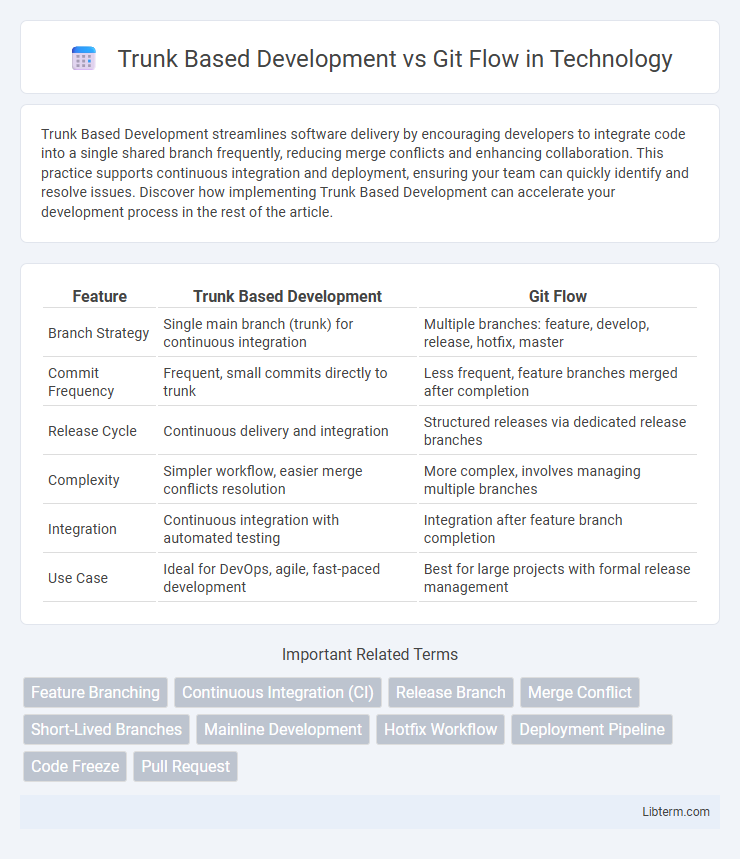Trunk Based Development streamlines software delivery by encouraging developers to integrate code into a single shared branch frequently, reducing merge conflicts and enhancing collaboration. This practice supports continuous integration and deployment, ensuring your team can quickly identify and resolve issues. Discover how implementing Trunk Based Development can accelerate your development process in the rest of the article.
Table of Comparison
| Feature | Trunk Based Development | Git Flow |
|---|---|---|
| Branch Strategy | Single main branch (trunk) for continuous integration | Multiple branches: feature, develop, release, hotfix, master |
| Commit Frequency | Frequent, small commits directly to trunk | Less frequent, feature branches merged after completion |
| Release Cycle | Continuous delivery and integration | Structured releases via dedicated release branches |
| Complexity | Simpler workflow, easier merge conflicts resolution | More complex, involves managing multiple branches |
| Integration | Continuous integration with automated testing | Integration after feature branch completion |
| Use Case | Ideal for DevOps, agile, fast-paced development | Best for large projects with formal release management |
Understanding Trunk Based Development
Trunk Based Development (TBD) emphasizes continuous integration by having developers commit small, frequent changes directly to the main branch, reducing merge conflicts and easing collaboration. This approach supports faster delivery cycles and improved code quality by integrating feature toggles and automated testing to maintain stability. Compared to Git Flow, which relies on multiple long-lived branches, TBD streamlines workflow and prioritizes keeping the codebase continuously deployable.
Overview of Git Flow Methodology
Git Flow methodology organizes development into distinct branches, including feature, develop, release, hotfix, and master, enabling parallel workflows and structured release cycles. Each branch serves a specific purpose: feature branches facilitate isolated development, develop branch integrates features, release branches prepare for production, hotfix branches address urgent issues, and master maintains stable production code. This branching strategy enhances code stability, supports versioning, and streamlines continuous integration and deployment processes.
Key Differences Between Trunk Based Development and Git Flow
Trunk Based Development emphasizes continuous integration by having all developers commit to a single main branch, minimizing long-lived feature branches and reducing merge conflicts. Git Flow relies on multiple long-lived branches such as develop, feature, release, and hotfix branches, which provides structured release management but can lead to integration delays. The primary difference lies in Trunk Based Development's focus on rapid, incremental changes, while Git Flow aims for organized version control through defined branching strategies.
Branching Strategies Explained
Trunk Based Development emphasizes a single main branch where developers frequently integrate small, incremental changes to maintain continuous integration and minimize merge conflicts. Git Flow employs multiple long-lived branches like feature, develop, release, and hotfix to organize development stages, which can increase complexity but provides clear separation of concerns. Branching strategies in Trunk Based Development promote faster feedback and simplified workflows, while Git Flow offers structured management suitable for larger projects with scheduled releases.
Advantages of Trunk Based Development
Trunk Based Development accelerates integration by encouraging developers to commit small, frequent changes directly to the main branch, reducing merge conflicts and improving code stability. This approach enhances continuous integration and continuous delivery (CI/CD) pipelines, enabling faster release cycles and more reliable software delivery. It also fosters better team collaboration and transparency, as all members work on a single shared codebase.
Benefits of Using Git Flow
Git Flow offers a structured branching model that simplifies release management by clearly separating feature development, releases, and hotfixes, enhancing team collaboration and minimizing integration conflicts. It provides a reliable workflow suited for projects with scheduled releases, enabling easier tracking of progress and well-defined versioning. The model's ability to isolate hotfixes ensures critical issues are addressed swiftly without disrupting ongoing development.
Challenges and Drawbacks of Each Approach
Trunk Based Development often faces challenges such as increased risk of integration conflicts due to frequent commits on a single main branch, potentially leading to unstable code if feature toggles are not properly managed. Git Flow, while providing structured release cycles with feature, develop, and release branches, introduces complexity in branching strategies that can slow down development velocity and complicate merges. Both approaches require disciplined team collaboration and robust CI/CD pipelines to mitigate risks associated with integration issues and deployment delays.
Which Teams Should Choose Trunk Based Development?
Trunk Based Development is ideal for teams prioritizing continuous integration, rapid deployment, and minimal merge conflicts, such as DevOps-focused or agile software development teams. Its approach supports small, frequent commits directly to the main branch, enhancing collaboration and reducing integration risks in fast-paced environments. Teams with high cross-functional collaboration and a culture of rapid iteration benefit most from adopting Trunk Based Development over more complex branching models like Git Flow.
When to Opt for Git Flow in Your Projects
Git Flow is ideal for projects with well-defined release cycles, multiple parallel versions, and a need for strict version control, such as enterprise software or large-scale applications with long-term support. It helps teams manage feature development, hotfixes, and releases systematically through clearly separated branches like develop, feature, release, and hotfix. Projects demanding rigorous release management and hotfix deployment benefit from Git Flow's structured branching model, ensuring stability while supporting continuous integration and delivery workflows.
Best Practices for Successful Implementation
Trunk Based Development emphasizes continuous integration with developers committing smaller, frequent changes directly to the main branch, minimizing merge conflicts and accelerating release cycles. Git Flow uses feature branches, release branches, and hotfixes to organize work, enhancing stability but requiring disciplined branch management to avoid integration delays. Best practices for successful implementation include establishing clear branching policies, enforcing code reviews, and integrating automated testing and continuous integration pipelines to maintain code quality and streamline deployments.
Trunk Based Development Infographic

 libterm.com
libterm.com